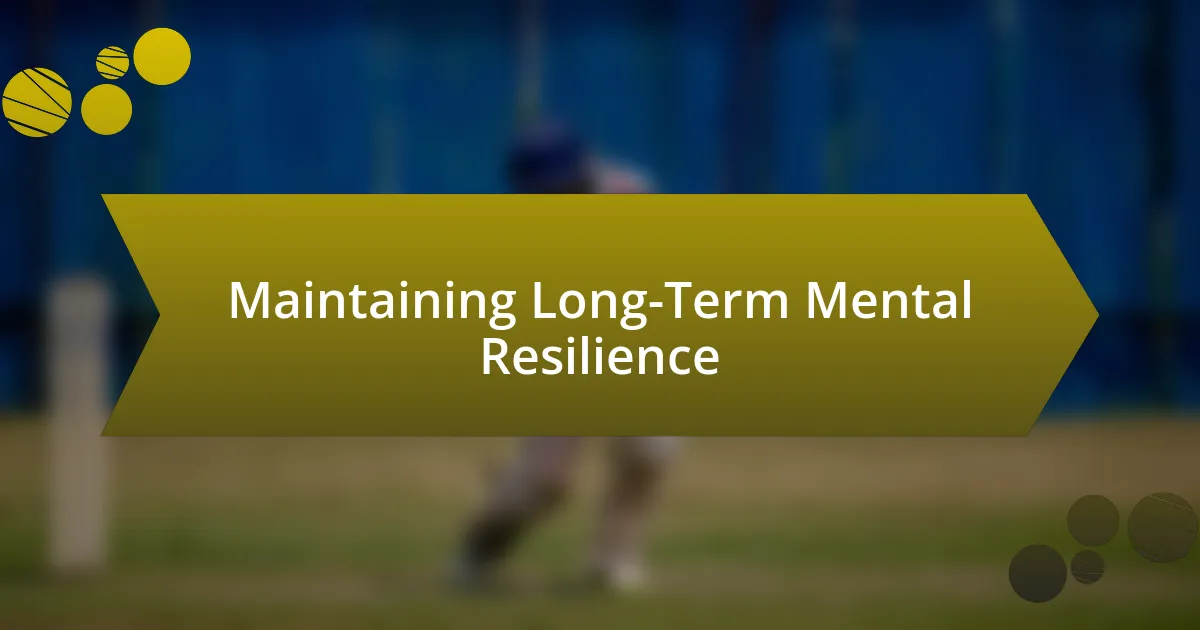Key takeaways:
- Negative thought patterns can be recognized as cognitive distortions, and understanding their triggers is essential for managing them.
- Techniques like cognitive restructuring, mindfulness practices, and maintaining thought records can effectively challenge and alter negative thoughts.
- Utilizing positive affirmations and building a supportive social network are crucial for enhancing mental resilience and countering negativity.
- Long-term mental resilience involves consistent self-reflection, mindfulness, and embracing change as a pathway for growth.

Understanding Negative Thought Patterns
Negative thought patterns can sometimes feel like a dark cloud hanging over us, influencing our perceptions and reactions. I remember a period in my life when I constantly thought, “I can’t do anything right.” This mantra was draining and distorted my self-image, making it hard to see the positive aspects of my life. Have you ever found yourself stuck in a similar loop?
Understanding these patterns often reveals that they are not just random thoughts; they can be deeply ingrained beliefs. For instance, after several failures, I found myself thinking that I was destined to fail. This kind of thinking is a cognitive distortion, a term used in psychology to describe how our minds can trick us into viewing situations in a overly negative light. Recognizing these distortions is the first step toward breaking free from them.
Another aspect to consider is how negative thoughts can trigger emotional reactions. When I would spiral into thoughts of inadequacy, I often felt a wave of sadness wash over me. This emotional response can create a vicious cycle, where our negative thoughts fuel negative feelings, making it even harder to escape the pattern. How do you usually feel when those negative thoughts creep in? Understanding this connection between thought and emotion can be pivotal in managing our mindsets.

Identifying Triggers of Negative Thoughts
Negative thoughts don’t appear out of thin air; they are often triggered by specific situations or experiences. I noticed that stressful environments, like a busy workplace or social gatherings, would ignite my inner critic. By observing these moments, I began to pinpoint other common triggers. Keeping a journal helped me track my thoughts and emotions, allowing me to identify patterns and gain clarity on what stirred these negative feelings.
Here are some common triggers I’ve found quite insightful:
- Stressful conversations or conflicts with others
- Personal setbacks or perceived failures
- Major life changes, like moving or starting a new job
- Social media use and the comparison game it can provoke
- Specific memories that evoke feelings of inadequacy or shame
Understanding these triggers empowers us to confront and manage them; I really felt a sense of control once I began recognizing my own. It’s amazing how awareness can dampen their impact, making them easier to navigate in the future.

Techniques for Challenging Negative Thoughts
Challenging negative thoughts requires active engagement and a thoughtful approach. One of the most effective techniques I’ve adopted is cognitive restructuring, where I consciously replace harmful thoughts with empowering ones. For instance, whenever I catch myself thinking, “I can’t handle this,” I switch to, “I’ve navigated tough situations before; I can do this too.” This simple shift not only alters my mindset but also boosts my confidence, allowing me to tackle challenges head-on.
Furthermore, I’ve found that mindfulness practices, such as meditation or deep-breathing exercises, play a crucial role in managing negative thoughts. These techniques help me ground myself in the present and reduce the overwhelming nature of my worries. I remember a particularly chaotic day when I felt anxiety creeping in; after just ten minutes of focused breathing, I regained my calm and clarity, allowing me to move forward with a more balanced perspective.
Finally, employing thought records has been truly transformative in my journey. I jot down negative thoughts, rate their intensity, and analyze their validity. This practice not only helps me see the irrationality behind some of my fears but also provides a tangible way to track my progress. It’s like shining a light on my internal dialogue, bringing patterns or recurring themes to the surface that I might otherwise overlook. Through this method, I’ve learned to challenge my thoughts honestly and compassionately.
| Technique | Description |
|---|---|
| Cognitive Restructuring | Replacing harmful thoughts with positive affirmations to shift mindset and boost confidence. |
| Mindfulness Practices | Using meditation and deep breathing to ground oneself and reduce anxiety about overwhelming thoughts. |
| Thought Records | Documenting negative thoughts to analyze their validity and track personal growth over time. |

Practicing Mindfulness for Thought Control
Practicing mindfulness has made a remarkable difference in how I manage negative thoughts. During moments when I feel overwhelmed, I often remind myself to focus on my breath. It’s fascinating how just a few deep breaths can anchor me, shifting my attention from spiraling thoughts to the rhythm of my inhales and exhales. This simple act of tuning into my body creates a space of calm, allowing me to regain control.
One particular instance stands out. I was caught in a cycle of self-doubt before an important presentation. I closed my eyes and engaged in a quick mindfulness exercise, visualizing my stress melting away like ice in the sun. After just a couple of minutes, I felt lighter and more present. I couldn’t help but reflect, how often do we let our thoughts run wild when we have the power to pause and redirect them?
Additionally, I’ve learned that mindfulness isn’t just about quieting the mind; it’s about recognizing thoughts without judgment. When I experience negative chatter, I now take a step back and acknowledge it without getting swept away. It’s a practice that fosters self-compassion—asking myself, “Is this thought helping me or holding me back?” This shift in perspective allows me to observe my internal dialogue rather than becoming entangled in it, reinforcing my belief in my ability to navigate life’s challenges with clarity and resilience.

Utilizing Positive Affirmations Daily
Utilizing positive affirmations daily has become a lifeline in my journey toward mental clarity. When I wake up each morning, I set the tone for my day by reciting affirmations that resonate with my goals and self-worth. Phrases like “I am capable of achieving my dreams” or “I embrace challenges with confidence” not only uplift my spirits but also help me cultivate a mindset that counters negativity.
One morning, I was feeling unusually heavy-hearted and unmotivated. As I stood in front of the mirror, I decided to turn that moment around by declaring, “I choose joy today.” It was surprising how such simple words transformed my perspective almost instantly, prompting me to look for moments that sparked happiness. Have you ever noticed how the words we speak can alter our emotional landscape?
Incorporating these affirmations into my daily routine has made them more than just words; they have become a powerful practice. Whenever self-doubt creeps in—perhaps during a tough project—I remind myself of my strengths by repeating, “I am enough.” This not only pushes back against negative thoughts but also reinforces my self-identity. Isn’t it amazing how a few affirming sentences can build a protective shield around our mental state?

Developing a Supportive Social Network
Building a supportive social network has been crucial in my approach to tackling negative thoughts. I remember a time when I felt particularly overwhelmed; reaching out to friends for a chat made a world of difference. Have you ever felt lighter after sharing your burdens with someone who truly listens?
Surrounding myself with positive individuals has reshaped my outlook on life. One of my close friends has a knack for providing just the right encouragement when negativity creeps in. It’s like having a personal cheerleader in my corner—do you have someone in your life who motivates you to push through tough situations?
Moreover, I’ve learned the importance of reciprocation within a supportive network. I strive to be there for others, sharing my experiences and offering a listening ear when they face challenges. This mutual support fosters an environment where we can all grow together, and honestly, it feels rewarding to be part of someone else’s healing journey. Isn’t it powerful how helping others can, in turn, elevate our own mental well-being?

Maintaining Long-Term Mental Resilience
Maintaining long-term mental resilience requires a conscious effort to cultivate healthy habits. Personally, I’ve found that mindfulness practices, like meditation and deep breathing, create a reservoir of calm that I can draw from during tough times. Have you ever taken a moment just to breathe and center yourself? It’s remarkable how a few minutes of stillness can shift my mindset from chaos to clarity.
Another key aspect is the importance of self-reflection. I keep a journal where I jot down my thoughts and feelings, which allows me to process negative experiences and recognize patterns in my thinking. One particularly tough week, writing about my frustrations not only helped me find solutions but also offered a sense of closure. How often do you take time to reflect on your emotions? Taking that time can be transformative.
Furthermore, I’ve learned to embrace change as a constant in life. When unexpected challenges arise, I try to remind myself that adaptability is a strength. For example, moving to a new city, while daunting at first, taught me resilience as I navigated unfamiliar territory. I often ponder, do you see challenges as obstacles or opportunities? Viewing them as opportunities to grow can fundamentally shift how we approach problems in our lives.













